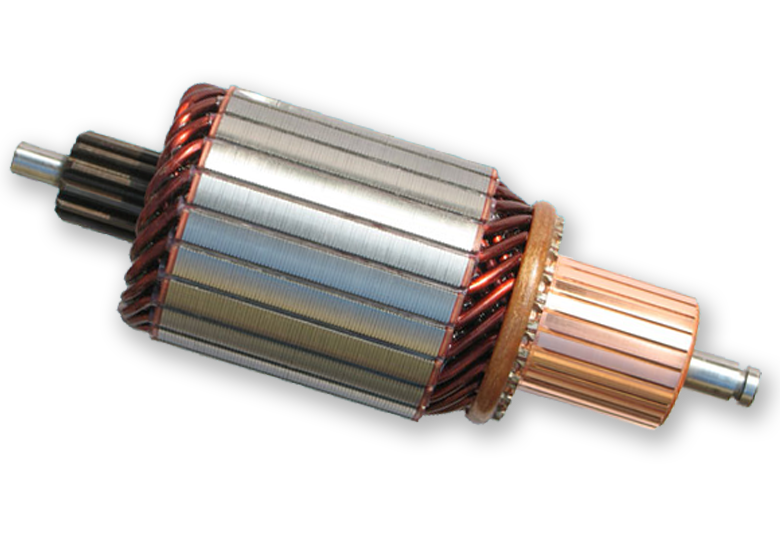What are the effects of unbalanced motor rotors on motor quality?

What are the effects of rotor imbalance on motor quality? In this article, the dynamic balancing machine technician mainly analyzes the vibration and noise problems caused by rotor mechanical unbalance, as well as the dynamic and static unbalance of the rotor.
Usually, the unbalance of motor rotors can be divided into static unbalance, dynamic unbalance, and mixed unbalance. The centrifugal force caused by static imbalance produces vibrations of equal magnitude and phase on two supports. The force couple of centrifugal force caused by dynamic imbalance produces equal magnitude and opposite phase vibrations on two supports. The most common problem encountered in practice is still mixed unbalance, which is the combined action of residual static unbalance centrifugal force and dynamic unbalance centrifugal force couple on two supports, producing vibrations of different sizes and phases. The mechanical imbalance of the rotor can be eliminated by balancing.
Motor rotor dynamic balance correction
1. Reasons for unbalanced vibration of the rotor: residual imbalance during manufacturing, excessive adhesion of dust generated during long-term operation, shaft bending caused by thermal stress during operation, unbalanced load caused by thermal displacement of rotor components, deformation or eccentricity caused by centrifugal force of rotor components, shaft bending caused by external forces (belts, gears, poor straightening, etc.), and poor bearing installation (shaft accuracy or locking) causing shaft bending or internal deformation of bearings.
2. How to suppress rotor unbalance: maintain it within the allowable unbalance, improve the excessive fit between the shaft and the iron core, address the anisotropy of thermal expansion, and design improvements. Improvement of strength design or assembly, correction of shaft strength design, change of type of shaft coupling and correction of straight coupling center, prevention of misalignment between bearing end face and shaft attachment section or locking nut.
3. The causes of abnormal vibration and noise in bearings include internal damage to the bearings, abnormal axial vibration of the bearings, and excitation of the vibration system composed of axial spring constant and rotor mass; Poor lubrication and bearing clearance are caused by cylindrical rolling bearings or large-diameter high-speed ball bearings.
4. Replacement of bearings: Apply appropriate axial spring preload to the variation of bearing clearance, choose soft grease or grease with excellent low-temperature performance, and minimize residual clearance (attention should be paid to temperature rise issues).
5. Method for rotor dynamic balance correction: After measuring the dynamic balance of the rotor in the dynamic balancing machine, the rotor can be balanced using the weighting and de weighting methods as needed. The so-called weighting method is to match the correction weight in the opposite direction of the imbalance. Common methods include welding, soldering, riveting, screwing, and adding weight blocks. The weight removal method is to remove a certain amount of weight in an unbalanced direction. The commonly used methods include boring, drilling, chiseling, milling, grinding, etc.

What are the effects of rotor imbalance on motor quality? In this article, the dynamic balancing machine technician mainly analyzes the vibration and noise problems caused by rotor mechanical unbalance, as well as the dynamic and static unbalance of the rotor.
Usually, the unbalance of motor rotors can be divided into static unbalance, dynamic unbalance, and mixed unbalance. The centrifugal force caused by static imbalance produces vibrations of equal magnitude and phase on two supports. The force couple of centrifugal force caused by dynamic imbalance produces equal magnitude and opposite phase vibrations on two supports. The most common problem encountered in practice is still mixed unbalance, which is the combined action of residual static unbalance centrifugal force and dynamic unbalance centrifugal force couple on two supports, producing vibrations of different sizes and phases. The mechanical imbalance of the rotor can be eliminated by balancing.
Motor rotor dynamic balance correction
1. Reasons for unbalanced vibration of the rotor: residual imbalance during manufacturing, excessive adhesion of dust generated during long-term operation, shaft bending caused by thermal stress during operation, unbalanced load caused by thermal displacement of rotor components, deformation or eccentricity caused by centrifugal force of rotor components, shaft bending caused by external forces (belts, gears, poor straightening, etc.), and poor bearing installation (shaft accuracy or locking) causing shaft bending or internal deformation of bearings.
2. How to suppress rotor unbalance: maintain it within the allowable unbalance, improve the excessive fit between the shaft and the iron core, address the anisotropy of thermal expansion, and design improvements. Improvement of strength design or assembly, correction of shaft strength design, change of type of shaft coupling and correction of straight coupling center, prevention of misalignment between bearing end face and shaft attachment section or locking nut.
3. The causes of abnormal vibration and noise in bearings include internal damage to the bearings, abnormal axial vibration of the bearings, and excitation of the vibration system composed of axial spring constant and rotor mass; Poor lubrication and bearing clearance are caused by cylindrical rolling bearings or large-diameter high-speed ball bearings.
4. Replacement of bearings: Apply appropriate axial spring preload to the variation of bearing clearance, choose soft grease or grease with excellent low-temperature performance, and minimize residual clearance (attention should be paid to temperature rise issues).
5. Method for rotor dynamic balance correction: After measuring the dynamic balance of the rotor in the dynamic balancing machine, the rotor can be balanced using the weighting and de weighting methods as needed. The so-called weighting method is to match the correction weight in the opposite direction of the imbalance. Common methods include welding, soldering, riveting, screwing, and adding weight blocks. The weight removal method is to remove a certain amount of weight in an unbalanced direction. The commonly used methods include boring, drilling, chiseling, milling, grinding, etc.
78 browse
